- A focused, cohesive vision
- Clarity of ownership and accountability
- Decisiveness
Thursday, December 07, 2006
Who Likes Peanut Butter Anyway?
I never liked peanut butter, so that may be the reason why Brad Garlinghouse's memo resonnated with me. His Peanut Butter Manifesto gives us a lesson in leadership. It is the responsibility of senior management to lead the march for change and to clearly articulate why it is happening. I found Brad's manifesto effective at doing so. Ironically enough, it would probably resonnate true with quite a few organizations were you to replace the product names. Organizations often tend to spread peanut butter when they are reluctant to refocus their business and align it with clearly articulated strategic direction. To be successuful, every organization should have:
Wednesday, December 06, 2006
Why Kodak’s Strategy Will Work…
The November 27th issue of Business week had a very interesting article about Kodak and some of the tough choices and strategy shifts it had to undertake over the past 10 years. Over the past ten years, Kodak had to re-invent itself from a film company to a print company to a digital technology provider illustrated by its recent deal with Motorola. So what's behind Kodak's transformation? First, despite the resistance to change that any strategy shift entails, is the recognition of a true identity and business purpose. Kodak is an image company and as such, it is able to adjust, though painfully, through the value chain of the image business.
In a sense, this is a classical illustration of Clayton Christensen's "Law of Conservation of Attractive Profits". The law of conservation of attractive profits states that in the value chain there is a requisite juxtaposition of modular and interdependent commoditization, that exists in order to optimize the performance of what is not good enough. When modularity and commoditization cause attractive profits to disappear at one stage in the value chain, the opportunity to earn attractive profits with proprietary products will usually emerge at an adjacent stage (quote from The Innovator's Solution). This happened to the computer industry (see Intel) and is happening to the image industry. Kodak's bet that the growth of digital photography will happen in mobile phone and that profits margins for sensor chips will be twice those of the digital camera business aligns with the above law. Kodak is identifying new revenue opportunity in the image value chain and aggressively pursuing the shift in the value chain. That's true leadership and it will pay off. Good luck Mr Perez.
In a sense, this is a classical illustration of Clayton Christensen's "Law of Conservation of Attractive Profits". The law of conservation of attractive profits states that in the value chain there is a requisite juxtaposition of modular and interdependent commoditization, that exists in order to optimize the performance of what is not good enough. When modularity and commoditization cause attractive profits to disappear at one stage in the value chain, the opportunity to earn attractive profits with proprietary products will usually emerge at an adjacent stage (quote from The Innovator's Solution). This happened to the computer industry (see Intel) and is happening to the image industry. Kodak's bet that the growth of digital photography will happen in mobile phone and that profits margins for sensor chips will be twice those of the digital camera business aligns with the above law. Kodak is identifying new revenue opportunity in the image value chain and aggressively pursuing the shift in the value chain. That's true leadership and it will pay off. Good luck Mr Perez.
Saturday, December 02, 2006
Meridio Records Management with SharePoint
I came across this interesting presentation from Meridio a couple days ago. Meridio positions itself as the leading worldwide provider of enterprise Document and Records Management (eDRM) software, engineered for Microsoft .NET platforms.
As a result, Meridio is naturally embracing SharePoint and identifying both how to position itself and provide value-added to SharePoint 2007. Meridio recognizes one of the weaknesses of the SharePoint architecture with the risk of proliferation of a large number of sites which in return makes the SharePoint infrastructure difficult to manage (if not unmanageable) for large organizations. SharePoint's approach to Records Management relies heavily on the site archictecture as well. See the Web Seminar with AIIM and Microsoft: Records Management in Microsoft Office SharePoint Server 2007 for a good overview.
Meridio is positioning itself as an enterprise policy management solution for SharePoint 2007 which can act as an enterprise records management repository for SharePoint and legacy systems as well.

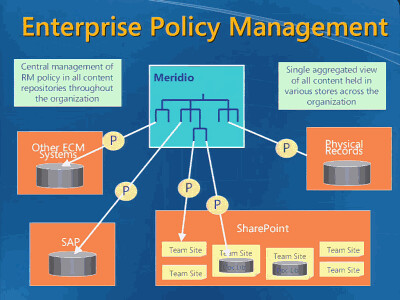
Here is a screenshot of Meridio’s policy management user interface in a SharePoint environment.
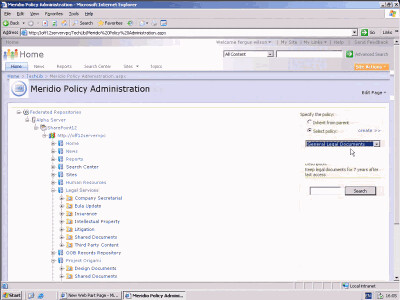
Meridio's architecture seems to start positioning Meridio as a potential virtual records management repository for the enterprise which is undoubtedly the right direction for them to remain relevant.
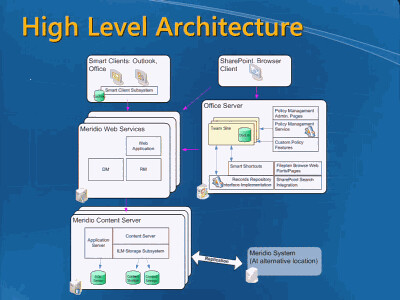
It is an interesting and promising extension to SharePoint. Remains to be seen how successful they will be now that SharePoint is positioning itself as a platform that can provide basic Records Management capabilities.
As a result, Meridio is naturally embracing SharePoint and identifying both how to position itself and provide value-added to SharePoint 2007. Meridio recognizes one of the weaknesses of the SharePoint architecture with the risk of proliferation of a large number of sites which in return makes the SharePoint infrastructure difficult to manage (if not unmanageable) for large organizations. SharePoint's approach to Records Management relies heavily on the site archictecture as well. See the Web Seminar with AIIM and Microsoft: Records Management in Microsoft Office SharePoint Server 2007 for a good overview.
Meridio is positioning itself as an enterprise policy management solution for SharePoint 2007 which can act as an enterprise records management repository for SharePoint and legacy systems as well.


Here is a screenshot of Meridio’s policy management user interface in a SharePoint environment.

Meridio's architecture seems to start positioning Meridio as a potential virtual records management repository for the enterprise which is undoubtedly the right direction for them to remain relevant.

It is an interesting and promising extension to SharePoint. Remains to be seen how successful they will be now that SharePoint is positioning itself as a platform that can provide basic Records Management capabilities.
Sunday, June 25, 2006
Interesting Open Source WSRP Consumers/Producers Compatibility Analysis
A colleague of mine recently pointed out an interesting presentation from CCLRC Daresbury Laboratory (University of Portsmouth) comparing experiences with open source portals WSRP development and testing.
By standardizing presentation-oriented web services, WSRP makes it possible to construct web portals in "plug-and-play" mode. This presentation compares WSRP support for the eXo Platform, Liferay, StringBeans and uPortal. WSRP4J, which is not a portal framework but a reference implementation of the WSRP 1.0 specification and the basis of WSRP support in many portal frameworks, is also discussed. In summary, WSRP Open Source implementations are still in early stages. From a producer standpoint, WSRP4J is clearly the most compatible of all and can be accessed by all the reviewed WSRP consumers. From a consumer standpoint, none of the consumers are fully functional. From Xiaobo Yang, Xiao Dong Wang and Rob Allan presentation, the test summary is shown below.
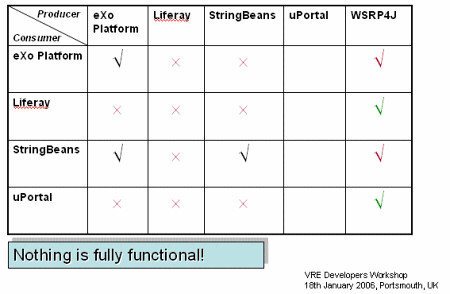
By standardizing presentation-oriented web services, WSRP makes it possible to construct web portals in "plug-and-play" mode. This presentation compares WSRP support for the eXo Platform, Liferay, StringBeans and uPortal. WSRP4J, which is not a portal framework but a reference implementation of the WSRP 1.0 specification and the basis of WSRP support in many portal frameworks, is also discussed. In summary, WSRP Open Source implementations are still in early stages. From a producer standpoint, WSRP4J is clearly the most compatible of all and can be accessed by all the reviewed WSRP consumers. From a consumer standpoint, none of the consumers are fully functional. From Xiaobo Yang, Xiao Dong Wang and Rob Allan presentation, the test summary is shown below.

Saturday, May 13, 2006
Jetspeed-2 Desktop: Client Side Portlet Aggregation
I have not had much time to get involved with Jetspeed lately, but when I read Steve Milek post on the development list last Monday, I figured I had to check out the new Jetspeed-2 desktop mode. And I have to say, this is shaping out quite nicely.
Essentially, the Jetspeed j2o Desktop mode combines Jetspeed server-side portal services with client side ajax services. Traditionally, Jetspeed has been a server centric application where every request is processed by the server request pipeline. In Jetspeed j2o desktop the page aggregation is controlled by the client services. This makes for a pretty sleek client experience. The Jetspeed j2o implementation significantly leverages the DOJO library and essentially implements a client side JSR 168 compliant portlet rendering engine. Some screenshots are enclosed below.
Jetspeed-2 Desktop View

Jetspeed-2 Desktop Portlet Drag and Drop

Jetspeed-2 Back in Normal Portal View
Users can switch back to the traditional Jetspeed view:
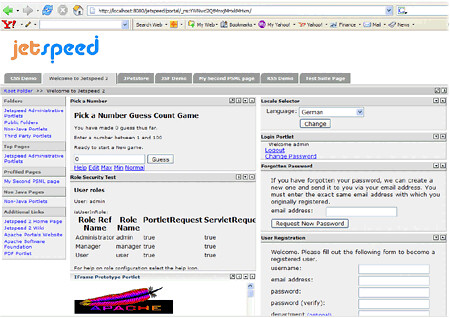
For more details, read Steve's post on the Jetspeed-2 dev list. Great job from the jetspeed team!
Essentially, the Jetspeed j2o Desktop mode combines Jetspeed server-side portal services with client side ajax services. Traditionally, Jetspeed has been a server centric application where every request is processed by the server request pipeline. In Jetspeed j2o desktop the page aggregation is controlled by the client services. This makes for a pretty sleek client experience. The Jetspeed j2o implementation significantly leverages the DOJO library and essentially implements a client side JSR 168 compliant portlet rendering engine. Some screenshots are enclosed below.
Jetspeed-2 Desktop View

Jetspeed-2 Desktop Portlet Drag and Drop

Jetspeed-2 Back in Normal Portal View
Users can switch back to the traditional Jetspeed view:

For more details, read Steve's post on the Jetspeed-2 dev list. Great job from the jetspeed team!
Saturday, April 22, 2006
Wikis: New Trend For Consumer Oriented Web Sites?
Wikis have been around for a while. The open source community has long been using them as a means of communicating project updates and documentation. The Wikipedia phenomenon has played a significant role in increasing awareness and demonstrating the power of Wikis. Now it is time for consumer oriented web sites to jump on the band wagon and leverage Wikis as a means to provide better alignment and customer focus for their web sites. How much customer focused can you be? There seems to be a trend for a new generation of consumer web sites to leverage Wikis as a way to foster their community involvement and provide better customer focus. Granted customer reviews have been around for a while; just select one product on Amazon and consumer reviews usually abound. The paradigm shift here? The entire site content is driven by the community. This has the potential for early adopters to disrupt their industry business models. Some examples:
- Trip Advisor: This is probably the best example. Trip Advisor is opening its travel guides content to the community at large. If this takes off, this could be quite disruptive to the travel guide industry. No more outdated content; get to read about the not so-well known places to visit. Leverage millions of tourists and local inhabitants to participate in writing Trip Advisor travel guides content. Look at what Wikipedia did to the Encyclopedia industry...
- Product Wiki: Another good example of what consumer shopping web sites could become. Let your community decide what you should sell and talk about. This could be fairly disruptive as well. Sell what your customers are looking for and develop micro communities of shopping web sites where customers drive what should be on the product catalog. The risk here is that, third party resellers figure out the trick to push and promote their own products. But with the proper controls in place, this concept has some potential.
- Wet Paint: Provide a framework to create Wikis focused on specific consumer areas. Check out Wiki XBox 360 for the XBox fans.
Sunday, March 26, 2006
Market Dynamics For Idea Validation
Here is an interesting idea. Use market dynamics to weed the good ideas from the bad ones. I just happened to read an interesting article from today's New York Times ("Here's an Idea: Let Everyone Have Ideas" by William C. Taylor) that outlines just that. I personally find the idea quite appealing. The premises go as follows:
- Allow anyone in your company to have Initial Public Offerings (IPOs) for their ideas.
- Have every employee allowed to trade $10,000 of those idea stocks.
- Let the market dynamics decide.
Saturday, March 04, 2006
Yahoo! Mail Beta - I am loving it...
I finally got access to the new Yahoo! Mail Beta and I am loving it. My favorite feature? The RSS reader. My Yahoo! already offered the ability to add RSS feed to your personal pages; well now even better, you can read your RSS feeds in your mail client with indicators of whether or not new items are available. I look forward to Yahoo! integrating RSS with Messenger next...


Sunday, February 05, 2006
An Interesting SOA Platfom Reference Model
I came accross a white paper from IDC that presented an interesting SOA platform reference model. According to IDC, any SOA platform should be made of:
Core Services
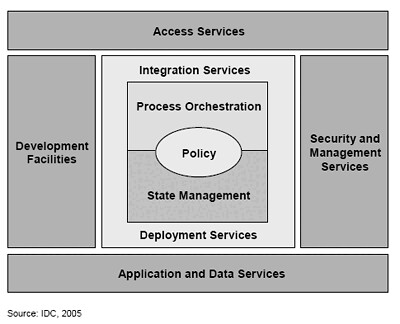 It shows the level of completness that application frameworks must provide in order to address the various requirements of SOA.
It shows the level of completness that application frameworks must provide in order to address the various requirements of SOA.
Core Services
- Deployment services. To host and manage the operational, runtime functions
- Integration services. Data and process-style integration across operating environments and platforms with support for demand-driven (request/reply) or event-driven interoperation
- Process orchestration. Organizes and aggregates services into flows to automate system and business processes
- Policy. A business policy or systems rule or condition that governs an action (Business rules are the foundation of business processes.)
- State management. The ability to recognize, support, and manage entity state, thereby providing support for processing governed by state transitions
- Access services. Reliable and secure system and people-based access to services and necessary system artifacts within the SOA
- Development facilities. Full life-cycle support and versioning of services and messages, including modeling, coding, debugging, testing, deployment, and change control
- Security and management services. Service and process monitoring, management, security, and ID management
- Application and data services. Services built around the supporting data persistence and data semantics
 It shows the level of completness that application frameworks must provide in order to address the various requirements of SOA.
It shows the level of completness that application frameworks must provide in order to address the various requirements of SOA.
Subscribe to:
Posts (Atom)